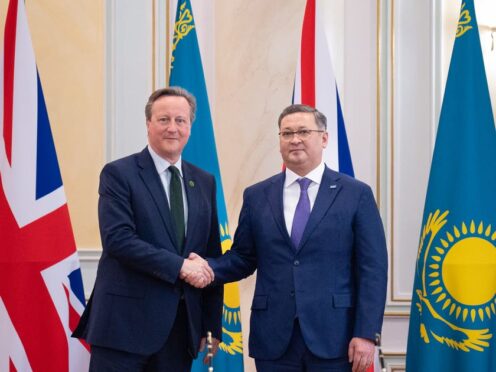Lord Cameron has insisted he can be “fully accountable” without facing scrutiny in the Commons chamber, saying he spends more time before peers than former ministers Lord Mandelson and Baroness Morgan did.
The Foreign Secretary defended the Government’s rejection of calls for him to appear at the Bar of the House by saying there was “no precedent” for it.
Critics from across the political divide have said that elected politicians should be able to question Lord Cameron, holder of one of the four great offices of state, in the lower chamber.
But he told the PA news agency: “I can justify it because I’m accountable to Parliament.
“I’m accountable in the House of Lords by doing questions every month for longer than my predecessors like Peter Mandelson or Nicky Morgan or other ministers sitting in the Lords have done.”
Lord Mandelson served in Gordon Brown’s Labour government as a peer after stepping down as an MP, while Baroness Morgan retained her Cabinet post in Boris Johnson’s ministry after being elevated to the Lords in 2020.
It comes after the Government was accused of misreading the mood of MPs by rejecting a recommendation by Parliament’s cross-party Procedure Committee for the Foreign Secretary to be scrutinised in the Commons.
MPs had suggested that an arcane procedure that allows visitors to appear at the Bar – the boundary beyond which non-MPs cannot pass – could be used for the Foreign Secretary to come before the lower House.
It has been used more than once, including in 1814 for the Duke of Wellington, who defeated Napoleon at the Battle of Waterloo, to address Parliament about the wars.
But Lord Cameron said: “I’m afraid I’m not responsible for anything of that magnitude so there isn’t a precedent and I think the Government has made the right decision.”
MP Andrew Mitchell, who was last month elevated to the newly created position of deputy foreign secretary, is “hugely capable” and answers questions for the Foreign Office in the Commons, Lord Cameron said.
The Foreign Secretary appeared to suggest he agreed with Mr Mitchell’s comments earlier this week that Kigali, the capital of Rwanda, is “arguably safer than London” and that some peers’ opposition to the Government’s Rwanda plan could “border on racism”.
He declined to repeat the remarks but said: “We always speak with one voice. I agree with him that the Rwanda policy is the right one.”
Asked whether he believes that Kigali is safer than London, Lord Cameron said: “I’m always driven by the data.”
